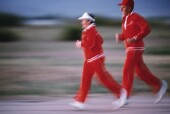
WEDNESDAY, May 14, 2014 (HealthDay News) — Is there a limit to the benefits of exercise? Two studies suggest that, for certain people, keeping to a moderate physical activity regimen may be best for heart health.
One study found that a schedule of intense workouts actually boosted the risk of death from heart attack or stroke in older people with pre-existing heart disease, while the other found that young men who did a lot of endurance exercise were at higher risk for heart rhythm problems later in life.
However, one expert unconnected to the studies stressed that, on the whole, exercise is good medicine.
“Folks with heart disease should continue to engage in some form of daily physical activity,” urged Barbara George, director of The Center for Cardiovascular Lifestyle Medicine at Winthrop-University Hospital in Mineola, N.Y. But she said moderation is key.
“You shouldn’t feel you have to become a marathon runner to reap the benefits,” George said.
The first study was led by Dr. Ute Mons of the German Cancer Research Center in Heidelberg, Germany, and included more than 1,000 people. Most of the participants were in their 60s, had stable heart disease and were tracked for 10 years. About 40 percent exercised two to four times a week, 30 percent worked out more often, and 30 percent exercised less often.
Compared to those who got regular exercise, the most inactive people were about twice as likely to have a heart attack or stroke, and were about four times more likely to die of heart disease and all causes, the researchers said.
However, Mons’ team also found that those who did the most strenuous daily exercise were more than twice as likely to die of a heart attack compared to those who exercised more moderately.
The second study was led by Dr. Nikola Drca of the Karolinska Institute in Stockholm, Sweden, and included more than 44,000 Swedish men, aged 45 to 79. All of the men were asked about their physical activity levels at ages 15, 30, 50 and during the previous year. Their heart health was then tracked for an average of 12 years.
Those who had done intensive exercise for more than five hours a week when they were younger were 19 percent more likely to have developed a heart rhythm disorder called atrial fibrillation by age 60 than those who exercised for less than an hour a week.
That risk increased to 49 percent among those who did more than five hours of exercise at age 30 but did less than an hour a week by the time they were 60. Participants who cycled or walked briskly for an hour or more a day at age 60 were 13 percent less likely to develop atrial fibrillation.
The studies were published online May 14 in the journal Heart.
Another expert said the findings shouldn’t alter standard recommendations.
“It is not standard practice to recommend strenuous activity to individuals with coronary heart disease,” said Dr. Nieca Goldberg, director of the Tisch Center for Women’s Health at NYU Langone Medical Center, New York City. “This study, although interesting, does not change current recommendations for moderate physical activity in coronary patients.”
For her part, George said it’s clear that a moderate exercise program can provide real benefit for everyone.
“A large body of scientific research has consistently shown that a sedentary lifestyle is one of the risk factors for cardiovascular disease, which includes heart disease, and that becoming more physically active can decrease your risk by as much as 50 percent,” she said.
Current American Heart Association guidelines advise 30 minutes of moderate-intensity aerobic exercise most days a week or 20 minutes of vigorous activity three days a week, George added.
And in a journal editorial, a team led by Dr. Lluis Mont of the Hospital Clinic of Barcelona, Spain, agreed with the two U.S. experts.
“The benefits of exercise are definitely not to be questioned; on the contrary, they should be reinforced,” the team wrote. But studies like the two published in Heart are fine-tuning recommendations for exercise, to “maximize benefits obtained by regular exercise while preventing undesirable effects — just like all other drugs and therapies,” the editorialists said.
More information
The U.S. National Heart, Lung, and Blood Institute offers a guide to physical activity.
Copyright © 2025 HealthDay. All rights reserved.

